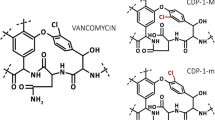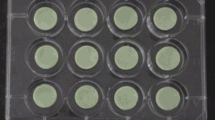Summary.
We have studied the mechanical and pharmacokinetic characteristics of an industrially-prepared bone cement containing 3 g of vancomycin per 60 g cement. A low viscosity cement was selected, to increase contact between the antibiotic and the infected surfaces. Resistance of compression (95 mPa) was well above the required standard (70 mPa) and similar to that of other cements with or without gentamicin. The concentrations in blood, urine and bone were measured in mg/l and mg/kg, and compared to the break point (BP) of susceptibility tests, which must be obtained to achieve control of infection. Diffusion tests were conducted in vitro (elution in saline from rods), and in 30 sheep femora implanted with the cement in vivo. In the animal study, bone levels during the first three months were three-fold higher than the BP (i.e., were ≥12 mg/l) in 92% of specimens from all areas of bone studied and at all times since implantation; they exceeded five times the BP in 56% of specimens and were never lower than twice the BP. The mean level was four times the BP after six months and fell sharply during the next six months. A pharmacokinetic study in ten patients who had a primary total hip arthroplasty with vancomycin-loaded cement as prophylactic antibiotic therapy showed that blood levels were lower than 3 μg/ml, i.e., 30 times lower than the toxic threshold (90 μg/ml). Vancomycin was undetectable in urine after the tenth day. The levels in drainage fluids were five times the BP after 24 h and equal to it after four days. None of the ten patients treated prophylactically with vancomycin-loaded cement developed evidence of allergy, toxicity, intolerance or loosening during a two year period. No adverse events were recorded in 17 other patients treated with a vancomycin (2 g) plus gentamicin (0.8 g) loaded cement as adjuvant therapy for severe prosthetic infection.
Résumé.
Compte-tenu de l’efficacité du ciment aux antibiotiques dans la prévention et le traitement des infections sur prothèses, nous avons étudié les caractéristiques mécaniques et pharmacocinétiques d’un ciment à la Vancomycine, car cet antibiotique est actif pratiquement sur tous les staphylocoques, même méti R. Il s’agissait d’un ciment à basse viscosité (pour optimiser le contact de l’antibiotique avec les surfaces infectées), préparé industriellement, compartant 3 grammes de Vancomycine pour 60 grammes de ciment. Les concentrations dans le sang, les urines et l’os étaient mesurées en mg/l ou mg/kg et comparées à la concentration critique (CC), qui doit être atteinte pour contrôler l’infection. Mécaniquement, la résistance en compression était de 95 mPa, et donc bien supérieure à la norme (70 mPa), et égale à celle d’autres ciments avec ou sans Gentamicine. Des études de diffusion ont été faites in vitro (élution dans du sérum à partir de bâtonnets), puis lors de 30 implantations fémorales chez la brebis. Le taux osseux était, jusqu’au 3ème mois après implantation, supérieur à 3 fois la CC (soit ≥12 μg/cc) dans 92% des prélèvements, quel que soit leur niveau dans l’os ou le délai (il dépassait 5 fois la CC dans 56% des prélèvements, et n’était jamais inférieur à 2 fois la CC). A 6 mois, le taux moyen était de 4 fois la CC, puis chutait avant un an. Pour connaître la pharmacocinétique en clinique de ce ciment, celui-ci a été utilisé comme antibioprophylaxie chez 10 premières implantations de prothèse totale de hanche: cette étude a permis de constater un taux sanguin inférieur à 3 μg/ml, soit 30 fois moins que le seuil de toxicité (90 μg/ml). L’antibiotique n’était plusretrouvé dans les urines au-delà de 10 jours. On retrouvait, dans les liquides de drainage péri-prothétiques, des taux de 5 fois la CMI à 24 heures, descendant jusqu’au taux de la CC en 4 jours. Aucun incident allergique, toxique, d’intolérance, ou de descellement n’était constaté chez ces 10 cas expérimentaux d’antibioprophylaxie (avec 2 ans de recul minimum), ni chez 17 autres patients chez lesquels un ciment Vancomycine (2 g) – Gentamicine (0,8 g) avait été utilisé comme traitement adjuvant d’une infection prothétique sévère.
Similar content being viewed by others
Author information
Authors and Affiliations
Additional information
Accepted: 30 November 1997
Rights and permissions
About this article
Cite this article
Chohfi, M., Langlais, F., Fourastier, J. et al. Pharmacokinetics, uses, and limitations of vancomycin-loaded bone cement. International Orthopaedics SICOT 22, 171–177 (1998). https://doi.org/10.1007/s002640050235
Issue Date:
DOI: https://doi.org/10.1007/s002640050235




